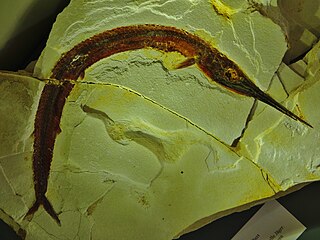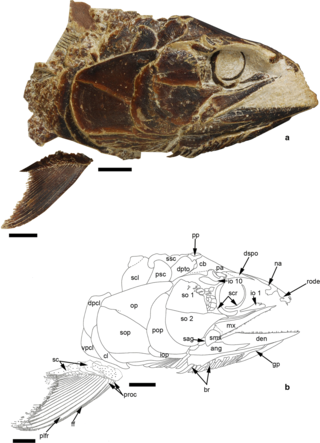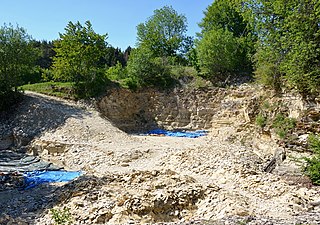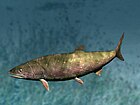
The Amiiformes order of fish has only two extant species, the bowfins: Amia calva and Amia ocellicauda, the latter recognized as a separate species in 2022. These Amiiformes are found in the freshwater systems of North America, in the United States and parts of southern Canada. They live in freshwater streams, rivers, and swamps. The order first appeared in the Triassic, and the extinct members include both marine and freshwater species, many of which are morphologically disparate from bowfins, such as the caturids.

Caturus is an extinct genus of predatory marine fishes in the family Caturidae in the order Amiiformes, related to modern bowfin. It has been suggested that the genus is non-monophyletic with respect to other caturid genera.

The operculum is a series of bones found in bony fish and chimaeras that serves as a facial support structure and a protective covering for the gills; it is also used for respiration and feeding.

Belonostomus is a genus of prehistoric ray-finned fish that was described by Louis Agassiz in 1844. It is a member of the order Aspidorhynchiformes, a group of fish known for their distinctive elongated rostrums.

Pachycormus is an extinct genus of pachycormiform ray-finned fish known from the Early Jurassic of Europe. The type species P. macropterus was first named as a species of Elops by Henri Marie Ducrotay de Blainville in 1818, it was placed into the newly named genus Pachycormus by Louis Agassiz in 1833. Fossils have been found in marine deposits from France, Germany and England. Pachycormus has recently been considered monotypic, only containing P.macropterus, with other species considered junior synonyms of the former, though this has subsequently been questioned. Pachycormus has generally been considered basal among Pachycormiformes, with a recent phylogeny finding it to be the second most basal pachycormiform after Euthynotus. It grew up to 1 m (3.5 ft) in length. The teeth are short and designed for grasping. Its ecology has been interpreted as that of a generalist predator. Stomach contents indicate that its diet included cephalopods, and small fish, including juvenile Pachycormus. One particular specimen shows that it died because of swallowing an ammonite too large for its size, and the ammonite itself was only shortly digested just before the fish's death.

Megalichthys is a genus of prehistoric lobe-finned fish which lived during the Devonian and Carboniferous periods. It is the type genus of the family Megalichthyidae. The type species is M. hibberti. The species M. mullisoni, named for fossil preparator C Frederick Mullison, is known from the Catskill Formation of Pennsylvania.

Allothrissops is an extinct genus of marine ray-finned fish in the family Ichthyodectiformes, or bulldog fish. It is known from the Late Jurassic of Germany, where it has been found in the famous Solnhofen Limestone.

Euthynotus is an extinct genus of prehistoric bony fish that lived during the early Toarcian stage of the Early Jurassic epoch. It is generally considered the basalmost pachycormiform.

Ainia is an extinct genus of prehistoric ray-finned fish that lived during the Kimmeridgian stage of the Late Jurassic epoch. It contains a single species, A. armata, known from the famous Solnhofen Limestone of Germany. It is a distant relative of the bowfin, although it is more closely related to genera such as Caturus and Osteorachis.

Coccolepis is an extinct genus of prehistoric marine ray-finned fish in the family Coccolepididae. Originally including most species within the family, it is now restricted to two species from the Late Jurassic Solnhofen Limestone of Germany. The holotype of C. bucklandi, designated and described by Louis Agassiz, was thought to be lost but was later rediscovered in Neuchâtel.
Plesiococcolepis is an extinct genus of prehistoric ray-finned fish. It belongs to the family Coccolepididae and is known from the Early Jurassic of Lingling-Hengyang, Hunan, China.
Pleuropholis is an extinct genus of prehistoric ray-finned fish.

The Solnhofen Limestone or Solnhofen Plattenkalk is a collective term for multiple Late Jurassic lithographic limestones in southeastern Germany, which is famous for its well preserved fossil flora and fauna dating to the late Jurassic (Kimmeridgian-Tithonian). The paleoenvironment is also often referred to as the Solnhofen Archipelago. The Solnhofen Archipelago was located at the northern edge of the Tethys Ocean as part of a shallow epicontinental sea and is firmly a part of the Mediterranean realm.

Cavenderichthys is an extinct genus of prehistoric freshwater ray-finned fish from the Late Jurassic. It contains a single species, C. talbragarensis from the Talbragar Fish beds of New South Wales, Australia.

The Nusplingen Limestone is a geological formation in Baden-Württemberg, Germany. It preserves fossils dating to the Kimmeridgian age of the Late Jurassic. It mainly consists of lithographic limestones deposited in a marine basin, similar to the Solnhofen Limestone. Fossils of pterosaurs, thalattosuchians, and the oldest geophilomorph centipede Eogeophilus were found in the Nusplingen Limestone.
This list of fossil fishes described in 2015 is a list of new taxa of jawless vertebrates, placoderms, acanthodians, fossil cartilaginous fishes, bony fishes and other fishes of every kind that have been described during the year 2015, as well as other significant discoveries and events related to paleontology of fishes that occurred in the year 2015. The list only includes taxa at the level of genus or species.

Eichstaettisaurus is a genus of lizards from the Late Jurassic and Early Cretaceous of Germany, Spain, and Italy. With a flattened head, forward-oriented and partially symmetrical feet, and tall claws, Eichstaettisaurus bore many adaptations to a climbing lifestyle approaching those of geckoes. The type species, E. schroederi, is among the oldest and most complete members of the Squamata, being known by one specimen originating from the Tithonian-aged Solnhofen Limestone of Germany. A second species, E. gouldi, was described from another skeleton found in the Matese Mountains of Italy. Despite being very similar to E. schroederi, it lived much later, during the Albian stage. Fossils of both species show exceptional preservation due to deposition in low-oxygen marine environments.

Ophiopsiella is an extinct genus of prehistoric ray-finned fish.
Furo is an extinct genus of ray-finned fish belonging to the order Ioniscopiformes that has been found in Europe. The type species is F. orthostomus.

Coccolepididae is an extinct family of ray-finned fish, known from the Early Jurassic to Early Cretaceous, most of which were originally referred to the type genus Coccolepis. They had a widespread distribution, being found in North and South America, Australia, Asia and Europe. They are mostly known from freshwater environments, though several species have been found in marine environments. They are morphologically conservative, and have poorly ossified endo and exoskeletons, which usually results in poor preservation. This makes it difficult to distinguish species. They are generally small fish, with the largest known specimens reaching a length of 210 mm. Historically, they have been classified as members of “Palaeonisciformes”, a paraphyletic grouping of non-neopterygian fish, due to their plesiomorphic conservative morphology closely resembling those of many other groups of primitive fish. Some recent authors have suggested that they may belong to the order Chondrostei as relatives of the Acipenseriformes.


















